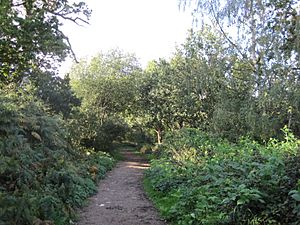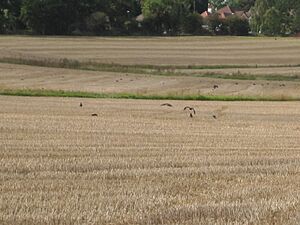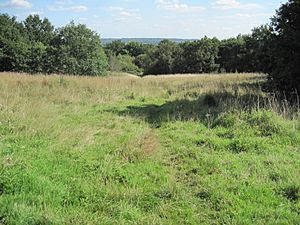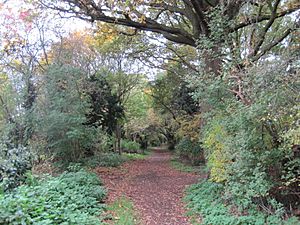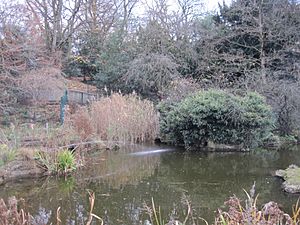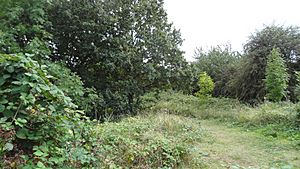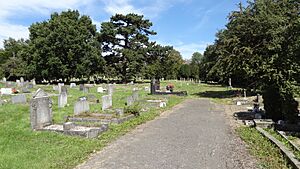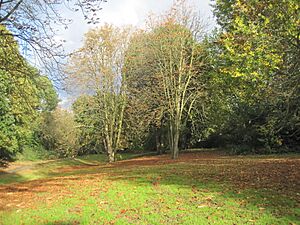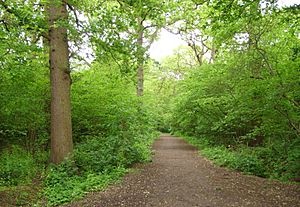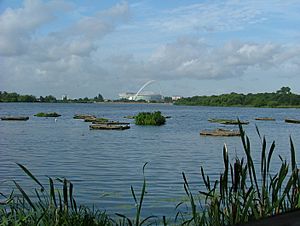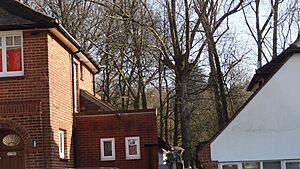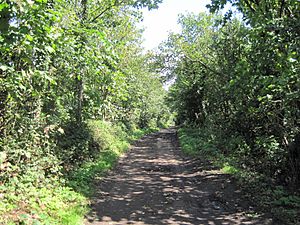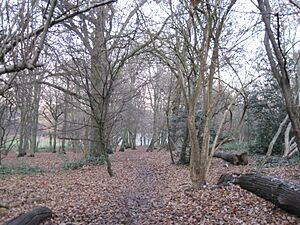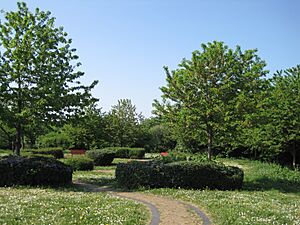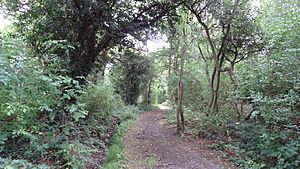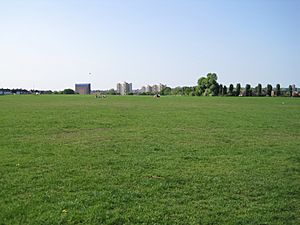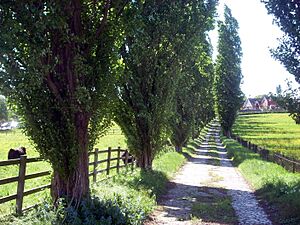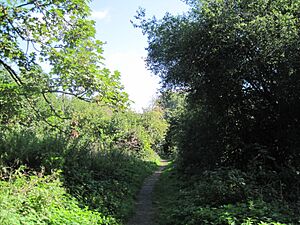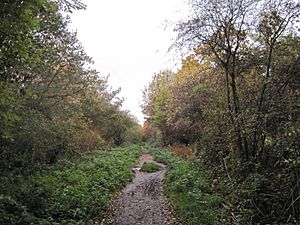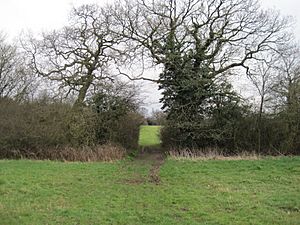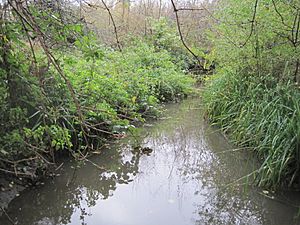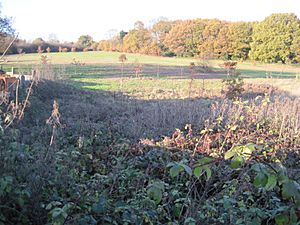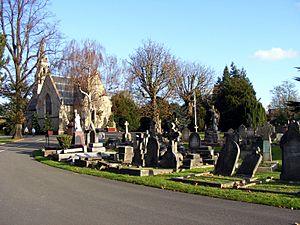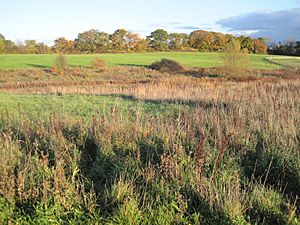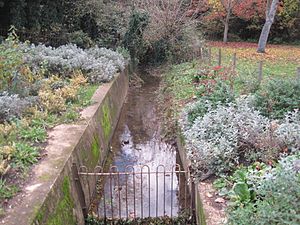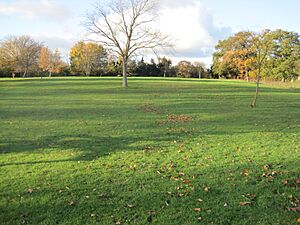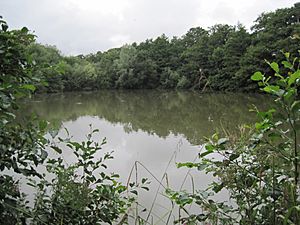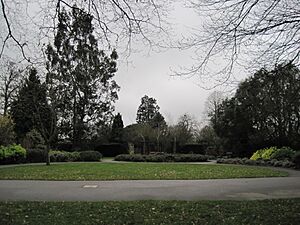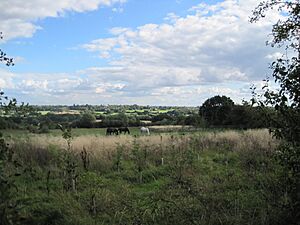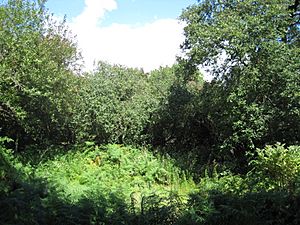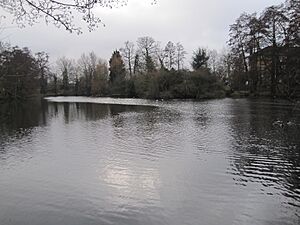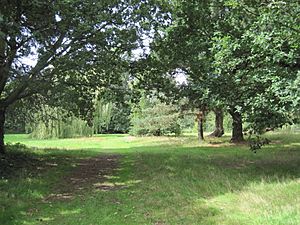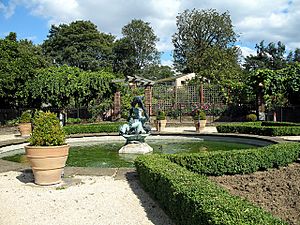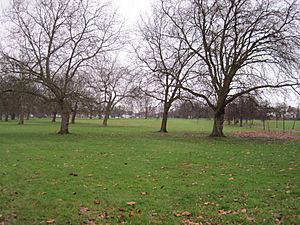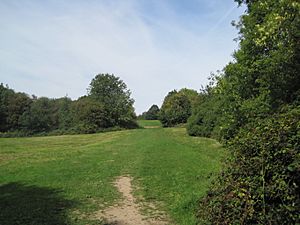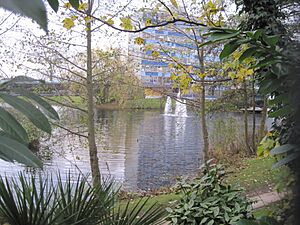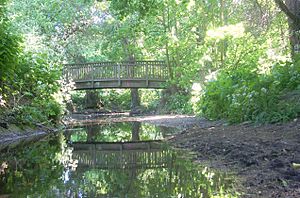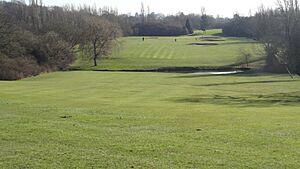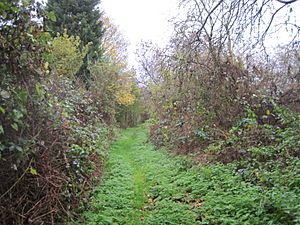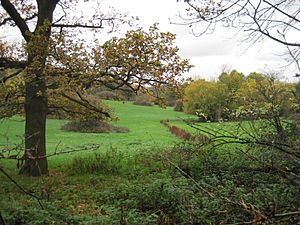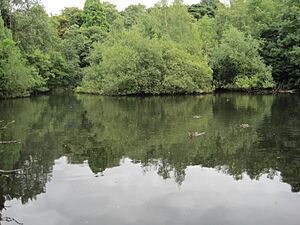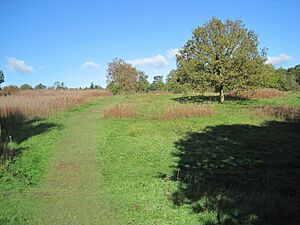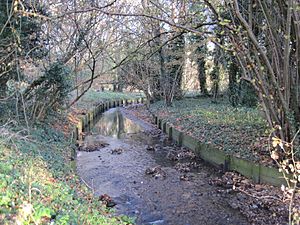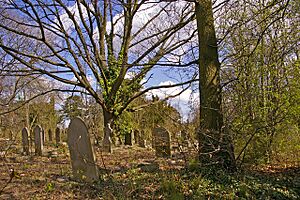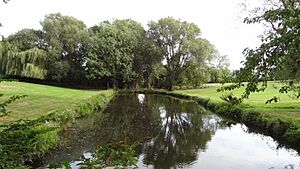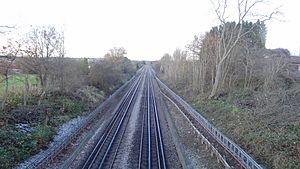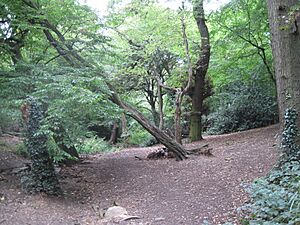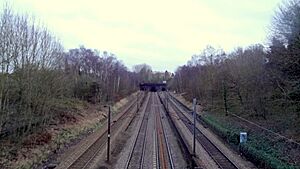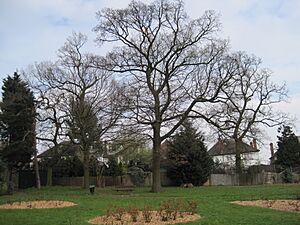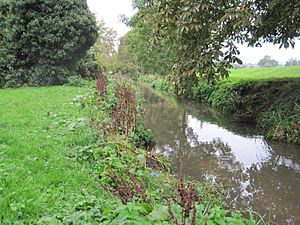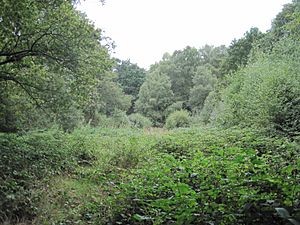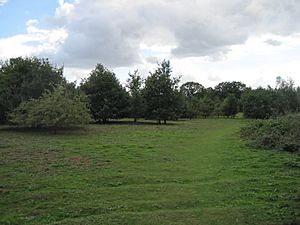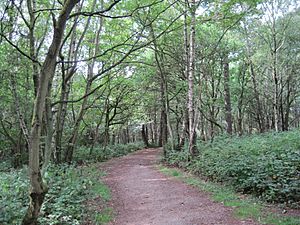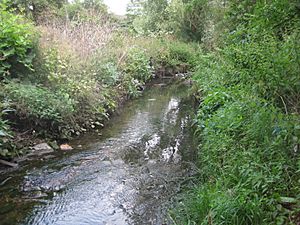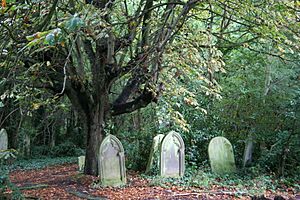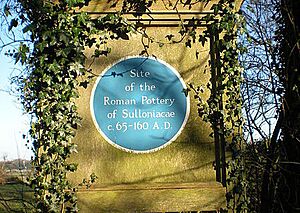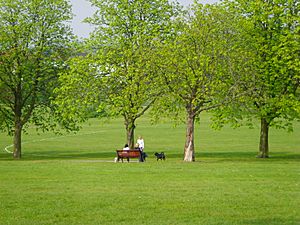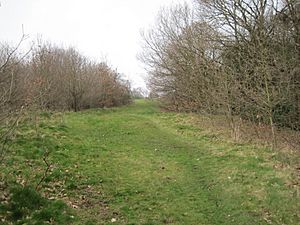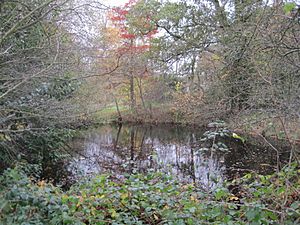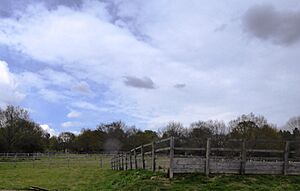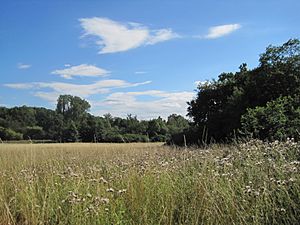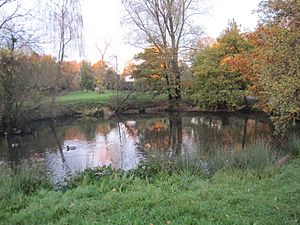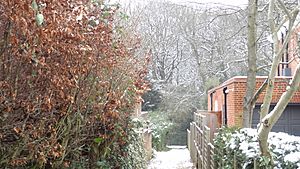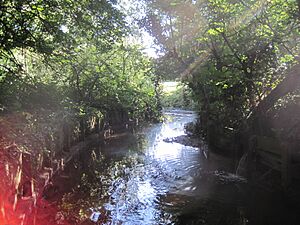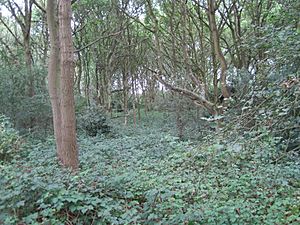List of nature reserves in the London Borough of Barnet facts for kids
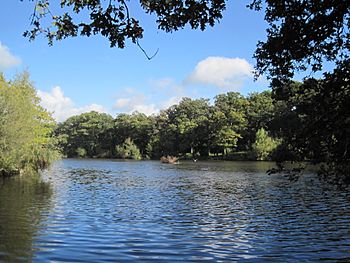
The London Borough of Barnet is a large area on the northern edge of London. While many people live here, Barnet is also full of amazing green spaces and farmland. Imagine almost one-third of Barnet (that's about 8,663 hectares or 21,400 acres) is protected as a "Green Belt"! This special rule was put in place after the Second World War to stop cities from growing too much into the countryside. Without it, Barnet would look very different today, and we wouldn't have so many wonderful nature spots.
Most of Barnet sits on something called "London Clay." This type of soil isn't great for farming, so much of the open land is used for fun activities like horse riding, sports fields, parks, and golf courses. Even with all this, you can still find parts of the old countryside, like ancient hedgerows, very old trees, and grasslands full of different wild flowers. Some of these hay meadows are so rich in plants that experts say they are some of Barnet's most important natural treasures!
Barnet has many areas that are specially protected. This helps keep them safe from building and makes sure Barnet's green spaces stay natural. Besides the Green Belt, there's also "Metropolitan Open Land" (about 690 hectares or 1,700 acres), which has similar strong protection. Plus, the Watling Chase Community Forest covers a huge area of 72 square miles (186 square kilometers), stretching from Totteridge into nearby Hertfordshire.
In 1992, Barnet Council asked the London Ecology Unit (LEU) to check out all the wildlife habitats in the borough. They looked at green sites covering about 4,055 hectares (10,020 acres), which is 45% of Barnet! In 1997, the LEU published a report called Nature Conservation in Barnet. This report listed 67 "Sites of Importance for Nature Conservation" (SINCs). These SINCs are important for planning decisions, helping to guide how Barnet's natural areas are looked after. While SINCs don't have special legal protection on their own, some of these sites are also "Sites of Special Scientific Interest" (SSSIs) or "Local Nature Reserves" (LNRs), which do have legal protection.
Contents
Exploring Barnet's Nature Spots
What Are Nature Reserves?
Nature reserves are special places where wildlife and plants are protected. In Barnet, many of these are called "Sites of Importance for Nature Conservation" (SINCs). These are areas that experts have identified as important for their wildlife, plants, or natural features. They help keep Barnet green and full of life!
How to Understand the List
Below is a list of these amazing nature spots in Barnet. To help you understand the table, here's a quick guide to the symbols used for access and type of site:
Access Information
- P = You can visit all or most of the site for free.
- PP = You can visit part of the site for free.
- PL = You can visit at certain times only.
- F = You can only access the site using public footpaths.
- V = You can only see the site from nearby paths or roads.
- NO = There is no public access to the site.
Type of Site
- M = Site of Metropolitan Importance – These are the very best examples of London's natural places, or they have rare plants and animals.
- B1 = Site of Borough Importance Grade 1 – These sites are very valuable to Barnet.
- B2 = Site of Borough Importance, Grade 2 – Similar to B1, but slightly less important.
- L = Site of Local Importance – These places are especially valuable to people living nearby or to schools.
- LNR = Local nature reserve – These sites are of special interest locally for their wildlife or geology.
- SSSI = Site of Special Scientific Interest – These are the country's best wildlife and geological sites, with strong legal protection.
- CL = Registered common land – You have free public access to all of these sites.
Important Places in Barnet
| Site | Photograph | Hectares | Location | Access | Type | Description |
|---|---|---|---|---|---|---|
| Arkley Lane and Pastures | 52 | Arkley 51°39′18″N 0°13′48″W / 51.655°N 0.230°W TQ 225 965 |
PP | B2 | This site includes Arkley Lane, a nearby woodland, and fields. The lane is an old path with huge oak, ash, and maple trees in its hedges. The woodland is very old and home to many nesting birds. | |
| Arkley South Fields | 38 | Arkley 51°38′28″N 0°13′55″W / 51.641°N 0.232°W TQ 224 951 |
V | B2 | This large area of open grassland has ditches and old hedges. It's super important for birds that nest in grasslands, like skylarks and meadow pipits. Skylarks are a special focus for conservation because their numbers have been going down. | |
| Arrandene Open Space and Featherstone Hill | 25 | Mill Hill 51°36′47″N 0°13′48″W / 51.613°N 0.230°W TQ 226 920 |
P | M | Experts say the fields here, separated by ancient hedges, are some of the best old hay meadows in London. Lots of wild flowers bloom in summer, and the woods are great for birds. | |
| Ashley Lane | 1 | Hendon 51°36′04″N 0°13′01″W / 51.601°N 0.217°W TQ 236 906 |
P | B2 | This old trackway is over 400 years old! It still has its original hedges with old oak and ash trees, plus some wild service-trees. The hedges are home to many different kinds of shrubs. | |
| Avenue House Grounds | 3.5 | Church End 51°35′51″N 0°11′37″W / 51.5975°N 0.1937°W TQ 251 902 |
P | L | This public park is the garden of Avenue House. It has pretty plants, a rockery, and a pond with hornwort, yellow iris, water-lilies, common frogs, and koi carp. There are also large areas of bushes. | |
| Barfield Allotments Nature Park | 0.9 | Whetstone 51°37′37″N 0°09′29″W / 51.627°N 0.158°W TQ 276 935 |
V | L | This small wildlife spot is next to a playground. Its bushes and grassland are a safe place for common lizards and slowworms, which are both protected by law. | |
| Barnet Countryside Centre | 2.8 | High Barnet 51°39′29″N 0°12′58″W / 51.658°N 0.216°W TQ 234 969 |
V | L | This center helps schoolchildren learn about farm animals and wildlife. It has woodlands with many birds, ponds with aquatic life, and open areas with lots of insects. | |
| Bell's Hill Burial Ground | 2.8 | High Barnet 51°38′56″N 0°12′54″W / 51.649°N 0.215°W TQ 235 959 |
P | L | This small cemetery has mown grass in one part, but another area is left wild with many different wild flowers. It's a great place to see butterflies like gatekeepers, small skippers, and meadow browns. | |
| Belmont Open Space, Cockfosters | 1.0 | Cockfosters 51°38′49″N 0°09′25″W / 51.647°N 0.157°W TQ 275 958 |
P | L | This hidden park has many wild flowers, old trees, and an ancient hedgerow. Local bird watchers have seen a wide variety of birds here, which is impressive for a small park in the suburbs. | |
| Big Wood and Little Wood | 8.6 | Hampstead Garden Suburb 51°34′59″N 0°11′24″W / 51.583°N 0.190°W TQ 255 887 51°35′10″N 0°11′35″W / 51.586°N 0.193°W TQ 253 890 |
P | B1 LNR | These woods are what's left of a very old, large forest. Big Wood has many types of trees and bushes, with oak trees being the most common. You can also find several old wild service-trees. All the usual woodland birds live here, and Little Wood even has a small outdoor theater. | |
| Brent Reservoir (Welsh Harp) | 46 | Hendon 51°34′16″N 0°14′42″W / 51.571°N 0.245°W TQ 215 871 |
P | M LNR SSSI | Brent Reservoir is Barnet's only Site of Special Scientific Interest (SSSI), meaning it's super important! It's a key breeding spot for ducks, geese, and other birds, including one of Britain's largest groups of great crested grebes. It also has many rare wetland plants and insects, including over forty rare types of invertebrates (bugs without backbones). It's even one of the few places in London where you can find water shrews. | |
| Bruno's Field | 6.6 | Mill Hill 51°37′34″N 0°14′46″W / 51.626°N 0.246°W TQ 215 934 |
NO | B2 | This field slopes steeply and has different types of land. Higher up, it's dry, but lower down, there are wet, boggy areas with small streams. The field has typical pasture plants, some old trees, and many different birds. | |
| Burtonhole Lane and Pasture | 8.5 | Mill Hill 51°37′12″N 0°12′25″W / 51.620°N 0.207°W TQ 242 927 |
PP | B2 | Burtonhole Lane is an old green path, now used for walking and horse riding. Its hedges have special trees like wild service-tree and black bryony, which suggests they are very old. The path's edge is full of wild flowers. The pasture area is mostly covered by Yorkshire Fog grass. Burtonhole Brook crosses the site, and it has some unusual plant species. | |
| Cherry Tree Wood | 4.7 | East Finchley 51°35′10″N 0°09′36″W / 51.586°N 0.160°W TQ 275 890 |
P | L | This local park was once part of a much larger forest belonging to the Bishop of London. It has a lawn, playground, and tennis courts, surrounded by very old woodland. The trees are mainly oak and hornbeam, and you can find plants like wild garlic and wood-sedge that grow in ancient woods. | |
| Clarefield Park | 3.2 | Brent Cross 51°34′19″N 0°13′16″W / 51.572°N 0.221°W TQ 232 874 |
P | L | This small park has mown grass, a children's playground, fragrant bushes, and a small wildlife pond. | |
| Clay Lane | 1.8 | Edgware 51°37′48″N 0°16′23″W / 51.630°N 0.273°W TQ 194 939 |
P | L | This is an ancient green lane that goes from Edgwarebury into the Hertfordshire countryside. An old hedge bank and plants usually found in ancient woodlands suggest it's very old. It has beautiful old oak trees with midland hawthorn, blackthorn, and hazel bushes underneath. | |
| Clitterhouse Recreation Ground | 16 | Brent Cross 51°34′08″N 0°12′54″W / 51.569°N 0.215°W TQ 238 871 |
P | L | This large sports field has interesting wildlife around its edges, where you can find plants like crab apple, typical of old hedgerows. | |
| College Farm | 4.5 | Finchley 51°35′35″N 0°12′07″W / 51.593°N 0.202°W TQ 246 897 |
PP | L | College Farm in Finchley was a working farm. It has trees and bushes that provide a home for birds, and pipistrelle bats have been seen here. | |
| Coppetts Wood and Scrublands Local Nature Reserve | 12 | Colney Hatch 51°36′32″N 0°09′25″W / 51.609°N 0.157°W TQ 277 915 |
P | B1 LNR | These sites offer many different homes for wildlife. Coppetts Wood has a type of plant called juneberry and a pond with yellow iris, where common frogs and smooth newts breed. Scrublands, once a sewage works, has rare plants and insects. | |
| Copthall Railway Walk and Copthall Old Common | 11 | Mill Hill 51°36′25″N 0°13′23″W / 51.607°N 0.223°W TQ 231 912 |
P | B2 | This green path follows an old railway line, with Copthall Old Common nearby. The grassland has many wild flowers. The hedges have beautiful old oaks and areas of bluebells. A pond on the common has yellow iris and water-starwort. You might also spot birds and insects, including glow-worms, which are becoming rare. | |
| Copthall South Fields | 6 | Mill Hill 51°36′07″N 0°13′59″W / 51.602°N 0.233°W TQ 225 908 |
P | L | These fields feel surprisingly rural, even though they are next to a busy road. The hedgerow trees are oak, ash, and field maple. The fields have flowers typical of clay grassland, like meadow vetchling, meadow buttercup, and common sorrel. | |
| Deans Brook and Stoneyfields Park | 3.3 | Edgware 51°37′30″N 0°15′47″W / 51.625°N 0.263°W TQ 203 929 |
PP | B2 | You can often see Kingfishers and grey wagtails along the two-kilometer Deans Brook. In Stoneyfields Park, the brook widens into a pretty lake with tall water plants like great and lesser reedmace. Birds like coots, moorhens, and mallards breed here. The park's woodland has oak and hazel trees, and its hedges have plants like wood-sedge and ramsons, showing they are very old. | |
| Drivers Hill | 10 | Mill Hill 51°36′58″N 0°13′16″W / 51.616°N 0.221°W TQ 231 920 |
V | B2 | This site has several fields and two small woods. The grassy areas have many types of grasses and wild flowers, including some that are typical of old pastures. Wetter areas have plants like tufted hair-grass and greater bird's-foot-trefoil. The woods are mostly oak, ash, and sycamore. | |
| East Finchley Cemetery | 16 | East Finchley 51°35′31″N 0°11′02″W / 51.592°N 0.184°W TQ 258 896 |
P | L | Most of this cemetery is well-kept, but it has some old oak trees from its past as countryside. Evergreen trees like cedar of Lebanon and Wellingtonia provide homes for goldcrests and coal tits. In less managed areas, you can find wild flowers like burnet saxifrage. | |
| Edgware Way Rough | 5.5 | Edgware 51°37′30″N 0°17′17″W / 51.625°N 0.288°W TQ 185 932 |
F | M | This grassland on London Clay hasn't been farmed for many years. In damp areas, it has London's largest group of the herb great burnet. Other rare plants found in old meadows include sneezewort and devil's-bit scabious. Birds that breed here include the yellowhammer and spotted flycatcher, both of which are declining. | |
| Edgwarebury Brook | 5 | Edgware 51°37′26″N 0°17′02″W / 51.624°N 0.284°W TQ 188 935 |
V | B2 | This stream starts in fields and flows through Edgware Way Rough into suburban Edgware, where it joins Deans Brook. The upper part of the stream is very important for wildlife, with lots of floating sweet-grass, brooklime, and water pepper. The banks have clumps of great willowherb and trifid bur-marigold. | |
| Edgwarebury Park | 15 | Edgware 51°37′30″N 0°16′59″W / 51.625°N 0.283°W TQ 190 934 |
P | L | The hedges in this large park have beautiful oak and ash trees. The presence of wild service-trees suggests these hedges are very old. You can find a variety of wild flowers in damp areas, and nesting birds include song thrush, mistle thrush, great spotted woodpecker, and common whitethroat. | |
| Folly Brook and Darland's Lake Nature Reserve | 11 | Arkley/Woodside Park 51°37′30″N 0°12′18″W / 51.625°N 0.205°W TQ 240 934 |
P | B1 | Darland's Lake was made by damming Folly Brook. The water is clean, and the lake has large areas of reeds. On its edge, there's a boggy wood of willows and alder, which is rare in London. The site has many tree species typical of ancient woodlands, and a diverse population of birds and insects. Eighteen different types of mammals have been seen here! | |
| Friary Park | 8.8 | Friern Barnet 51°37′05″N 0°09′43″W / 51.618°N 0.162°W TQ 273 926 |
P | L | Old oak trees here existed before the park was created, and they support woodland birds like nuthatches and treecreepers. Near a small stream, you can find wild flowers such as cow parsley, lesser celandine, dog violet, and garlic mustard. | |
| Glebe Lane Pastures | 11 | Arkley 51°38′42″N 0°14′02″W / 51.645°N 0.234°W TQ 223 954 |
V | B1 | This area of five fields was once part of a shared pasture called Barnet Common. The grassland is natural clay grassland, a leftover from the old common. It has many types of wild flowers, especially old meadow plants. Some rare plants have been found in temporary pools, like bog stitchwort and pond and ivy-leaved crowfoot. | |
| Glebelands Local Nature Reserve | 7.5 | Colney Hatch 51°36′14″N 0°10′08″W / 51.604°N 0.169°W TQ 270 911 |
P | B1 LNR | This is a small piece of the old Finchley Common. It has tall bushes and woodland, along with many streams and seasonal ponds. The pools have several rare species, and it's the only known place in London for lesser water-plantain. Other rare plants include thread-leaved water-crowfoot (Ranunculus trichophyllus) and marsh speedwell. Many different birds breed here. | |
| Greenhill Gardens | 1.5 | High Barnet 51°38′41″N 0°10′57″W / 51.6446°N 0.1824°W TQ 258 955 |
P | L | The main feature of this small park is its large lake with a wooded island. Water birds like mallards, mute swans, coots, and moorhens live here. Pipistrelle and noctule bats have been seen hunting for food over the lake. | |
| Hadley Green | 10 | Monken Hadley 51°39′40″N 0°11′56″W / 51.661°N 0.199°W TQ 246 973 |
P | M | Hadley Green was the site of a big battle in 1471 during the Wars of the Roses. It's mostly grassy with some wetter areas and several ponds. It has a number of rare plants, such as mat-grass and oval sedge in the grassland, lesser spearwort and marsh ragwort in the ditches, and tufted forget-me-not and fiddle dock in the ponds. You can also find eleven different types of dragonflies and damselflies here. | |
| Hampstead Heath Extension and Golders Hill Park | 46 | Golders Green 51°34′30″N 0°11′10″W / 51.575°N 0.186°W TQ 258 878 |
P | M | Experts have described the hedges of Hampstead Heath Extension as some of the best on the Heath. It also has a series of seven ponds with many different aquatic plants. Golders Hill Park has both formal gardens and wilder areas. Swan Pond is a large ornamental lake with various exotic and native wildfowl. | |
| Hendon Park and Northern Line Railway Cutting | 14 | Hendon 51°34′55″N 0°13′19″W / 51.582°N 0.222°W TQ 233 884 |
P | L | This site is mostly informal parkland with mown grass and old trees. Many small birds feed among the tall hedges at the northern end. The railway cutting has rough grassland and patches of woodland, providing a home for birds like the great spotted woodpecker and goldcrest. | |
| King George's Fields | 27 | Monken Hadley 51°39′22″N 0°11′42″W / 51.656°N 0.195°W TQ 250 969 |
P | B2 | This site is mostly covered with coarse grasses, but it also has fields rich in herbs, with wild flowers commonly found in natural grasslands. Oak trees grow in old hedges, and birds like sparrowhawks and stock doves breed here. | |
| Lakeside Nature Reserve | 0.6 | Church End 51°35′58″N 0°11′06″W / 51.5994°N 0.1850°W TQ 257 904 |
V | L | This site is a lake with a small island behind an office block, surrounded by trees. The island is a safe breeding ground for wildfowl, protected from animals that might hunt them. The lake also has fish, frogs, toads, and terrapins. | |
| Lower Dollis Brook, Brent Park and River Brent | 28 | Woodside Park/Hendon 51°34′19″N 0°14′10″W / 51.572°N 0.236°W TQ 243 906 |
P | B2 | This site includes Dollis Brook and the River Brent. At the Woodside Park end, there's a wild area with old ivy-covered oaks and alder trees. Brent Park has a lake that might have been created almost a thousand years ago! It has a wooded island that provides a safe place for birds. | |
| Mill Hill Golf Course | 60 | Mill Hill 51°38′02″N 0°15′32″W / 51.634°N 0.259°W TQ 206 942 |
NO | B1 | The golf course has several small streams that flow into Stoneyfields Lake. Around the edges of the fairways, you can find a variety of wild flowers, some of which are leftovers from old farm meadows. The most important part for wildlife is an area of acid grassland with the rare plant dyer's greenweed. | |
| Mill Hill Old Railway Nature Reserve | 9 | Mill Hill 51°36′43″N 0°15′25″W / 51.612°N 0.257°W TQ 203 917 |
PL | B2 | This long nature reserve follows an old railway line and is managed by the London Wildlife Trust. The woodland has oak and sycamore trees, with bushes like hawthorn, blackthorn, and grey willow. The grassland has many wild flowers, and the site is home to a large number of slow-worms. | |
| Mill Hill Substation Pastures | 15 | Mill Hill 51°37′00″N 0°12′38″W / 51.6168°N 0.2106°W TQ 240 925 |
V | M | Experts have called this site a "remarkable example" of natural, herb-rich grassland on damp clay soil, with many beautiful and locally uncommon wild flowers. Burtonhole Brook crosses the site, creating a damp area, and old hedges and small woodlands provide a safe place for birds. | |
| Moat Mount Open Space and Barnet Gate Wood | 110 | Mill Hill 51°38′02″N 0°15′11″W / 51.634°N 0.253°W TQ 215 943 |
P | B2 LNR | Moat Mount is a large, hilly area with open fields and old hedges in its valleys. Near the top of the hill, the woodland opens up to Leg of Mutton Pond, which has clumps of water-lilies and Nuttall's waterweed. The site also includes Barnet Gate Wood, which is probably a leftover from an ancient forest. | |
| Monken Hadley Common | 72 | Monken Hadley 51°39′36″N 0°10′37″W / 51.660°N 0.177°W TQ 263 972 |
P | B1 CL | This large common is mostly wooded, with small grassy areas. Daubenton's bats hunt over Jack's Lake, which is an artificial lake. The main trees are oak, hornbeam, and beech, and the ground has several plants that only grow in ancient woodlands. Birds like sparrowhawks, tawny owls, and cuckoos breed here. | |
| Mutton Brook | 13 | Hampstead Garden Suburb 51°35′13″N 0°12′36″W / 51.587°N 0.210°W TQ 251 892 |
P | L | This brook is a small river that flows into the River Brent. Oak, ash, and willow trees line its banks, providing homes for birds. Grey wagtails hunt for food at the water's edge. Woodland wild flowers include dog's mercury and winter heliotrope. | |
| New Southgate Cemetery | 20 | Brunswick Park 51°37′26″N 0°08′38″W / 51.624°N 0.144°W TQ 286 933 |
P | B2 | Parts of this cemetery that are no longer used for burials are managed for nature. These areas have woodland and open grassland, with young oak, ash, birch, and sycamore trees growing among older oak and yew trees. Many birds breed here, such as green and great spotted woodpeckers, coal tits, and nuthatches. This cemetery is also the most northern known place to find the dusky cockroach, which is a native species. | |
| North Middlesex Golf Course Ponds | 0.8 | Whetstone 51°37′16″N 0°10′05″W / 51.621°N 0.168°W TQ 269 930 |
NO | B2 | These ponds are one of the few places in Barnet where you can find palmate newts, and there's also a group of the more common smooth newts. The pond edges have some Michaelmas daisies and water mint. A ditch leads to a small woodland, which is likely an important path for amphibians. | |
| Northern Line Embankment, High Barnet | 6.5 | Totteridge/High Barnet 51°38′28″N 0°11′06″W / 51.641°N 0.185°W TQ 256 951 |
V | B2 | The plants here range from low bramble bushes to light woodland, providing a home for small birds like tits and finches. The most important thing about this site is that it's one of Barnet's few known places where common lizards live. They are protected here because there are no pesticides, dogs, cats, or people to disturb them. | |
| Oak Hill Wood | 10 | East Barnet 51°38′27″N 0°09′08″W / 51.6409°N 0.1521°W TQ 280 951 |
P | B1 LNR | This wood is managed by the London Wildlife Trust. The trees are oak, hornbeam, and ash, with some horse chestnut trees. Ground plants include bluebell and wood speedwell. A small stream flows through the wood, and a meadow has common wild flowers and butterflies. Several bat species also live here. | |
| Oakleigh Park Rail Cutting | 8.0 | Oakleigh Park 51°37′59″N 0°09′43″W / 51.633°N 0.162°W TQ 272 944 |
V | L | This site has a mix of different habitats. One side has open bramble bushes with clumps of blackthorn, hawthorn, and dog-rose. The other side has a mature woodland of oak, ash, and sycamore trees, with goat willow in wetter areas. Tall herbs are good for seed-eating birds like goldfinches, wrens, and dunnocks. | |
| Princes Park | 1.2 | Temple Fortune 51°34′55″N 0°12′22″W / 51.5820°N 0.2061°W TQ 243 885 |
P | L | This small park is well-maintained with mown lawns and flowerbeds. However, some of the old trees are older than the surrounding houses. In the south-east corner, a small woodland seems to be a piece of an old farm wood. Mature hawthorn trees around the edge might be leftovers from old farm hedges. | |
| Pymme's Brook | 13 | Monken Hadley/New Southgate 51°37′55″N 0°08′46″W / 51.6320°N 0.1462°W TQ 284 942 |
P | B2 | Two separate parts of Pymme's Brook are included here. The northern part, which runs for 500 meters from Monken Hadley, goes through rough grassland and scattered bushes, with a narrow strip of oak woodland. The three-kilometer southern part, leading to the border with Enfield, is mostly wooded. One section is very old, with wild service-trees, midland hawthorn, field maple, and crab apple trees. | |
| Rowley Green Common | 4.9 | Arkley 51°39′01″N 0°14′36″W / 51.6502°N 0.2433°W TQ 217 960 |
P | M LNR CL | This site has a mix of habitats with different conditions and many rare species. Most of it is woodland with fairly young trees. The most important area for wildlife is a sphagnum bog, which is extremely rare in south-east England. The site also has an area of acid grassland and a pond that supports many wetland plants. | |
| Rowley Lodge Field | 4.4 | Arkley 51°38′44″N 0°14′28″W / 51.6456°N 0.2410°W TQ 218 955 |
F | B2 | This is an old hay meadow with a few oak trees and small patches of bushes. It has many different wild flowers, including great burnet and pignut. Areas of acid grassland are mostly covered by red fescue, along with sheep's sorrel and tormentil. | |
| Scratchwood | 57 | Mill Hill 51°38′24″N 0°15′50″W / 51.640°N 0.264°W TQ 201 948 |
P | M LNR | Part of Scratchwood is ancient woodland, possibly dating back to the end of the last ice age. It has small streams, tall sessile oaks, and old hornbeams. Other areas include Bluebell Wood, which is more open and has large carpets of wild flowers. Scratchwood Pond has marshy areas nearby that are very rich in plants. | |
| Silk Stream and Burnt Oak Brook | 8 | Edgware 51°35′56″N 0°15′32″W / 51.599°N 0.259°W TQ 207 903 |
PP | B2 | These streams are important "wildlife corridors" that run through suburban areas. You can often see Mallards and grey wagtails along the banks, and fish like three-spined stickleback live in the water. The streams are best seen when they flow through parks like Silkstream Park, Montrose Recreation Ground, and Rushgrove Park. | |
| St Pancras and Islington Cemetery | 74 | East Finchley 51°36′00″N 0°09′54″W / 51.600°N 0.165°W TQ 272 907 |
P | B2 | Parts of this cemetery that are no longer used for burials are managed to help nature. These areas have woodland and open grassland. Strawberry Vale Brook flows through the north-east corner. The woodland's undergrowth is surprisingly rich, including pignut, goldilocks buttercup, cuckooflower, primrose, wild, and barren strawberries. | |
| Sulloniacis Pastures | 4.2 | Edgware 51°37′55″N 0°18′07″W / 51.632°N 0.302°W TQ 176 940 |
V | B2 | Most of this site is grassland rich in herbs, growing on London Clay. It has many flowers typical of clay pastures, such as greater bird's-foot-trefoil, burnet saxifrage, agrimony, and devil's-bit scabious. There are also small areas of woodland and bushes. | |
| Sunny Hill Park and Hendon Churchyard | 22 | Hendon 51°35′49″N 0°13′48″W / 51.597°N 0.230°W TQ 227 901 |
P | L | Most of this site is formal parkland, but at the southern end, there's a wild flower meadow with black knapweed, common sorrel, lesser stitchwort, and three types of buttercup. An area at the northern end is managed to protect slow-worms. | |
| The Mill Field | 3.4 | Mill Hill 51°37′19″N 0°14′10″W / 51.622°N 0.236°W TQ 221 929 |
P | B2 | The more natural part of this site has grassland with scattered oak and willow bushes, and old trees and hedges around the edges. There are many different wild flowers, and the small copper butterfly has been seen here. A small pond has rich aquatic plants, including nodding bur-marigold and branched bur-reed. | |
| Totteridge Common | 3 | Totteridge 51°37′53″N 0°13′22″W / 51.6315°N 0.2227°W TQ 230 939 |
P | B2 CL | The trees here are mostly sycamore and elm, but it also has two black poplars, which are considered England's most threatened native tree. The most important feature for wildlife is a series of old ponds, which are valuable for dragonflies, other insects, and amphibians. Plants in the deep water include white water-lily and curled and broad-leaved pondweeds. | |
| Totteridge Croft Field (or Dell's Down Acre) | 2.4 | Totteridge 51°37′34″N 0°11′53″W / 51.626°N 0.198°W TQ 248 934 |
NO | B1 | Experts described this site as an interesting example of natural clay grassland. Much of it is covered with tufted hair-grass, but there's a lot of variety between the different fields. It has many wild flowers, including uncommon species like sneezewort and pignut. | |
| Totteridge Fields and Highwood Hill | 103 | Arkley TQ 231 945 51°37′55″N 0°14′02″W / 51.632°N 0.234°W TQ 222 935 |
PP | M LNR | This site has large areas of natural grassland with old hedges. Part of it is a local nature reserve managed by the London Wildlife Trust. There are many different wild flowers, including some that are uncommon locally. Birds like the skylark, which is a declining species, breed here. A number of beetles and spiders found here are rare across the country. | |
| Totteridge Green | 4.6 | Totteridge 51°37′41″N 0°11′43″W / 51.6281°N 0.1953°W TQ 250 936 |
P | B2 CL | This is a typical English village green with open grassland, scattered trees, small areas of bushy woodland, and a pond. The main grasses are perennial rye-grass and other common meadow species. There are several damp hollows, probably old ponds, which have uncommon wild flowers like great burnet and bog stitchwort. Woodland plants include soft shield-fern, which is rare in this area. | |
| Turner's Wood | 2.4 | Hampstead Garden Suburb 51°34′20″N 0°10′43″W / 51.5722°N 0.1785°W TQ 263 875 |
NO | B2 | This private nature reserve is a small piece of Bishops Wood, which was part of the Bishop of London's land in medieval times. The land is hilly, with two small streams flowing through the middle. The main tree is sessile oak, with many different plants underneath, including rowan, midland hawthorn, and some wild service-trees. The site is managed to protect nature, especially for birds. | |
| Upper Dollis Brook | 40 | Mill Hill/Woodside Park 51°34′18″N 0°14′10″W / 51.5717°N 0.2361°W TQ 253 943 |
P | B1 | This six-kilometer stretch of the brook runs from Arkley to Woodside Park. The site also includes nearby areas like Whetstone Stray and Wyatt's Open Space, which have meadows full of flowers, divided by old hedges. The hedges have uncommon bushes like spindle and buckthorn. Birds like kingfishers, grey wagtails, and moorhens can be seen along the stream. | |
| Woodridge School Nature Reserve | 2.5 | Woodside Park 51°37′22″N 0°11′44″W / 51.6227°N 0.1955°W TQ 250 930 |
P | L | This small site was created as a nature garden for local primary schools. It has young oak woodland and rough grassland with wild flowers like pignut and yellow archangel. |
See also


